Search results
Mercury is a chemical element; it has symbol Hg and atomic number 80. It is also known as quicksilver and was formerly named hydrargyrum (/ h aɪ ˈ d r ɑːr dʒ ər ə m / hy-DRAR-jər-əm) from the Greek words hydor (water) and argyros (silver).
The smallest planet in our solar system and nearest to the Sun, Mercury is only slightly larger than Earth's Moon. From the surface of Mercury, the Sun would appear more than three times as large as it does when viewed from Earth, and the sunlight would be as much as seven times brighter.
Jun 9, 2023 · Mercury is the closest planet to the sun and also the smallest planet in the solar system. The small and cratered planet does not have any moons and zips around the sun faster than any other...
6 days ago · Isn't that wild? Credit: NASA/JPL-Caltech. Structure and Surface. Mercury is the smallest planet in our solar system. Mercury is a terrestrial planet. It is small and rocky. Mercury has a thin exosphere. Mercury’s surface can be as hot as 800 degrees F during the daytime and as cold as -300 degrees F during the nighttime.
Oct 19, 2018 · SCIENCE. STARSTRUCK. Planet Mercury, explained. Learn more about the innermost planet in our solar system. By Victoria Jaggard. 7 min read. Named for the fleet-footed Roman messenger god,...
Oct 20, 2023 · Mars. Jupiter. Saturn. Uranus. Neptune. Mercury is the closest planet to the Sun, with its average distance about 36 million miles (58 million km).
Mercury is the smallest planet in the Solar System. One of five planets visible with the naked eye a, Mercury is just 4,879 Kilometres across its equator, compared with 12,742 Kilometres for the Earth. Mercury is the second densest planet. Even though the planet is small, Mercury is very dense.



















